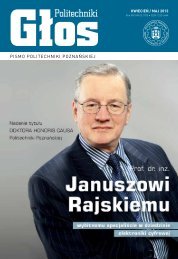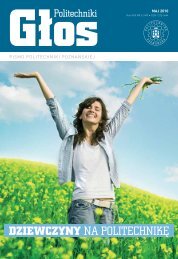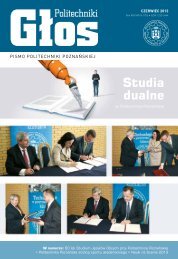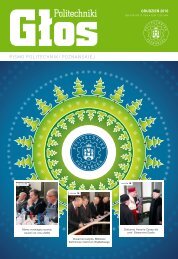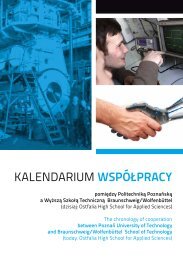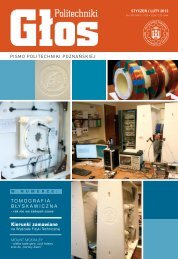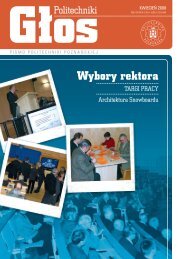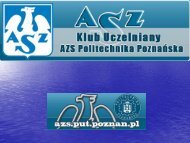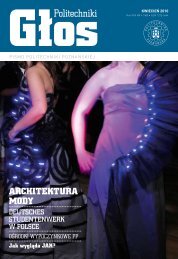2WATER PROCEEDINGS.pdf - AktualnoÅci Politechniki PoznaÅskiej
2WATER PROCEEDINGS.pdf - AktualnoÅci Politechniki PoznaÅskiej
2WATER PROCEEDINGS.pdf - AktualnoÅci Politechniki PoznaÅskiej
You also want an ePaper? Increase the reach of your titles
YUMPU automatically turns print PDFs into web optimized ePapers that Google loves.
systemem informacji wizualnej, z dostępem do bezprzewodowego Internetu, przestrzeń współczesna w swoim wyrazie<br />
materiałowym i technologicznym i jednocześnie szanująca substancję historyczną. Bulwar będzie żył swoim życiem będąc<br />
jednocześnie częścią miasta jak tylko to możliwie bezkolizyjnie integrującą ruch pieszy, rowerowy, oraz w przyszłości zaktywizowany<br />
ruch komunikacji zbiorowej i indywidualnej na rzece.<br />
Borys SIEWCZYŃSKI<br />
Wydział Architektury, Politechnika Poznańska<br />
WATER IN URBAN SPACE AS AN ELEMENT OF THE REAL TIME COMPUTER SIMULATION<br />
The article discusses the possibility of a supplementation of public space with the virtual elements added using<br />
the Augmented Reality technology. Article describes the contemporary possibilities of implementing the above mentioned<br />
real-time simulation as well as ongoing research. Short analysis of the possible impact of the described technical solutions<br />
on the perception of urban space is described. Paper discusses also some aspects of the impact of change to reality<br />
supplemented by computer simulation to the practice of design and social participation in the processes of urbanization<br />
WODA W PRZESTRZENI MIEJSKIEJ JAKO ELEMENT KOMPUTEROWEJ SYMULACJI CZASU RZECZYWISTEGO<br />
W artykule omówiono możliwość wirtualnego uzupełnienia przestrzeni miejskiej za pomocą elementów dodanych w wyniku<br />
zastosowania techniki Augmented Reality (rzeczywistości uzupełnionej). Artykuł relacjonuje współczesne możliwości<br />
realizacji wyżej wspomnianej symulacji czasu rzeczywistego jak i obecnie prowadzone prace badawcze. Podjęto próbę<br />
analizy możliwego wpływu opisywanych rozwiązań technicznych na sposób postrzegania przestrzeni miejskiej. Opisano<br />
wybrane aspekty wpływu opisywanych symulacji komputerowych rzeczywistości uzupełnionej na praktykę projektową oraz<br />
partycypację społeczną w procesach urbanizacyjnych.<br />
Marcin SPYRA<br />
Wydział Budownictwa, Politechnika Opolska<br />
WATER IN TRANSFORMATION PROCESS OF CITY SPACE. CASE STUDIES FROM ŚWIDNICA AND SIERADZ<br />
The paper analyzes the issue of water versus transformation process of city space. Author describes that issue at two selected<br />
case studies. In the paper introduction mentioned issue was shown in the historical and contemporary context. Two projects<br />
were selected as a case studies for this paper. The first project refers to revitalization of Central Park in Świdnica. One of<br />
the main spatial elements of this park is Młynówka Canal. The second project refers to revitalization of public space in Cultural<br />
Park “Wzgórze Zamkowe” located in Sieradz. River Żeglina and its old river-bed are important elements of this space. In both<br />
projects new design method called “The Project Acupuncture” was used. In the recapitulation of the paper the issues of<br />
changing conditions of designing and planning of public spaces were examined.<br />
WODA W PROCESIE TRANSFORMACJI PRZESTRZENI MIEJSKIEJ. STUDIUM PRZYPADKU ZE ŚWIDNICY I SIERADZA<br />
Problematyka tekstu dotyczy roli wody w procesie transformacji przestrzeni miejskiej. Zagadnienie opisano na dwóch wybranych<br />
przykładach projektowych. We wstępie problematyka ta została przedstawiona w skróconym ujęciu procesów historycznych<br />
oraz najważniejszych czynników wpływających na kształtowanie współczesnej przestrzeni miejskiej. Jako opis studium<br />
przypadku przyjęto dwa projekty rewitalizacji przestrzeni publicznych polskich miast. Pierwszy z projektów dotyczy rewitalizacji<br />
Parku Centralnego w Świdnicy, którego jednym z głównych elementów przestrzennych jest kanał Młynówki. Tematyka drugiego<br />
projektu związana jest z rewitalizacją przestrzeni publicznej Parku Kulturowego „Wzgórze Zamkowe” w Sieradzu. Istotnym<br />
elementem tej przestrzeni jest rzeka Żeglina oraz jej starorzecze. Obydwa zadania projektowe realizowane były w oparciu o autorską<br />
metodę noszącą nazwę „Akupunktury Projektowej”. W podsumowaniu podjęta została próba odniesienia się do problematyki<br />
zmieniających się uwarunkowań związanych z procesem planowania i projektowania transformującej się przestrzeni miejskiej.<br />
Kees STEGENGA<br />
Werkplaats voor Stedenbouw, Tilburg<br />
COASTAL MANAGEMENT IN THE SOUTHWEST PART OF THE DUTCH DELTA<br />
The heavy storm and its flood of 1953 directly led to one of the largest Dutch environmental projects: the Delta Works.<br />
The Dutch established an excellent international reputation with this Delta Works. Coastal reinforcement gave security for<br />
the residents and water management created conditions for the agricultural sector by reducing the salinity. The whole project<br />
fitted into the faith of the fifties en sixties of a makeable world. Climate change and associated sea level rise forcing the<br />
Netherlands to a further round of coastal defences in the Delta region. The one-dimensional technocratic approach of the Grand<br />
Project of the second half of the last century is increasingly abandoned. Climate adaptation, coastal protection and nature<br />
regeneration go hand in hand and provide opportunities for recreational functions and associated economic developments. This<br />
integrated approach is crucial for a region that faces a sharp decline of its own population and the traditional means of economic<br />
livelihood.<br />
Krystyna STRUMIŁŁO<br />
Instytut Architektury i Urbanistyki, Politechnika Łódzka<br />
ROLE OF WATER IN FORMING OF AREA IN THE CITY<br />
Article is attempt of presentation of relationship of water with city tissue and capabilities of its utilization in landscape of city.<br />
Simultaneously it shows that can have influence on forming of area and behavior of people. We want to aim at elevation of<br />
quality of public area. By creating of attractive places in city we built important elements which have esthetic value. Analysis of<br />
chosen example has to show positive influence of water on quality this area. Characteristic of adjacent area has to illustrate<br />
utilization of place for water also, concepts program and spatial which are with water directly relate. It is proper to build



